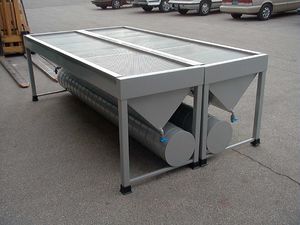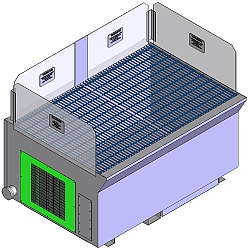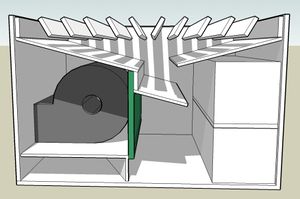Downdraft Tables
Downdraft tables or Downdraught benches are workstations with built-in ventilation to capture and filter dust, smoke, and fumes and then return the filtered air to a shop floor which can eliminate costly exhaust and energy loss. Downdraft tables can be used in a number of applications, and are available in a variety of sizes. Whether you need to capture smoke, dust or fumes, a downdraft table will filter the air in order to eliminate the pollutants.
Basic information
Downdraft tables are an efficient and economical way to protect workers from hazardous dust, smoke and fumes resulting from applications such as chemical preparation, woodworking, welding, processing explosive materials, sanding, buffing, polishing, grinding and finishing. By providing a cleaner, healthier work environment and thereby facilitating improved productivity for fine hand work, downdraft tables offer advantages for both companies and workers. Downdraft tables are ideal for industries such as metalworking, woodworking, pharmaceutical, automotive, coal handling, agricultural products and recycling. One of the advantages of downdraft tables over other systems is that they can be customized in numerous ways to fit a particular application, without having to retrofit an integrated dust collection system.
Down draft tables are designed to contain and exhaust heavier than air particles, lighter than air particles, fumes, fine particulates and powders. The top of downdraft tables is a perforated rigid grill through which airflow is both possible and uniform. Once air is pulled down through the perforated top it enters an exhaust chamber mounted directly underneath the top. The exhaust chamber contains filters that can capture particles as small as .5 microns. Some tables are equipped with pulse-jet air blasters directed at the filter that periodically clear off the filter to improve its operation. In addition, the exhaust chamber has multiple branch ducts attached underneath with balance dampeners attached to decrease the noise level. Everything underneath the exhaust chamber is enclosed into a duct that can connect to a facility’s duct collection system or can have an output area on the side or back of the chamber for the filtered air. There are two main types of downdraft tables: wet downdraft tables and dry downdraft tables. Wet downdraft tables employ a standard filter element and a liquid, typically water, in order to collect flammable metal dusts like magnesium, aluminum or titanium. Wet dust collectors in downdraft tables feature a number of additional devices including impellers for water reversal, sludge containers for captured metal particles, water level controls, after-filtration devices and mist eliminators. Dry downdraft tables are simpler, employing a standard filter element to collect vapors, dust, smoke or fumes. Besides wet versus dry, downdraft tables also vary by size, downdraft airflow, minimum particle size filtered and efficiency.
Advantages
- Regain Air: a portion of the clean, filtered air is returned through a plenum across the top of the station to form a Clean Air Curtain, pushing the contaminants away from the worker's breathing zone.
- Transparent Enclosure: High-grade plastic panels or moveable clear vinyl curtains contain the contaminants within the workstation environment.
- Backdraft Plus Downdraft: Source capture is maximized by pulling dust down and away from worker breathing zone.
- Integral Dust Collector: High-efficiency cartridge filters are vertically oriented for optimal loading and cleaning, as well as longer filter life.
- Edge-to-Edge High Velocity: With large diameter, backward-inclined airfoil blower wheels, the Benchtron provides consistent velocity across the work surface, even for stations up to 12 feet long.
- Leg Room: Every Benchtron station is built with leg room so workers may sit or stand.
- Variable Dimensions and Configurations: Optimized for the size of the operation, amount of available shop space, and number of workers, the BENCHTRON may be single or double (back-to-back), up to 48 inches deep and up to 12 feet long. In a large capacity unit with dual worksurfaces, industries can gain the advantages of the Benchtron features and performance at a price that is competitive with a multiple of cheaper, lightweight downdraft tables.
- Custom Design: Filter 1 customizes the Benchtron for special needs, including features such as a slotted crane roof, pneumatic turntable for lifting and spinning parts, or an adjustable up-and-down table.
Video


